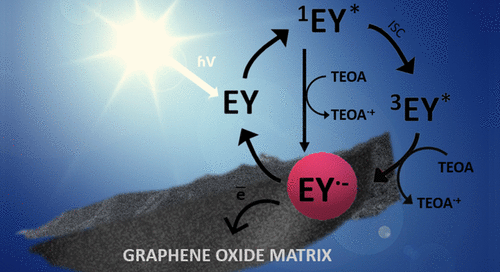当前位置:
X-MOL 学术
›
J. Phys. Chem. C
›
论文详情
Our official English website, www.x-mol.net, welcomes your feedback! (Note: you will need to create a separate account there.)
How Eosin Y/Graphene Oxide-Based Materials Can Improve Efficiency of Light-Driven Hydrogen Generation: Mechanistic Aspects
The Journal of Physical Chemistry C ( IF 3.7 ) Pub Date : 2020-01-22 , DOI: 10.1021/acs.jpcc.9b09573 Anna Lewandowska-Andrałojć 1, 2 , Daria Larowska 1 , Ewelina Gacka 1 , Tomasz Pedzinski 1, 2 , Bronislaw Marciniak 1, 2
The Journal of Physical Chemistry C ( IF 3.7 ) Pub Date : 2020-01-22 , DOI: 10.1021/acs.jpcc.9b09573 Anna Lewandowska-Andrałojć 1, 2 , Daria Larowska 1 , Ewelina Gacka 1 , Tomasz Pedzinski 1, 2 , Bronislaw Marciniak 1, 2
Affiliation

|
We have demonstrated that the photocatalytic system, containing Eosin Y (EY) as a sensitizer, triethanolamine (TEOA) as a sacrificial electron donor, CoSO4 as a catalyst, and graphene oxide (GO), exhibited a 9-fold increase in hydrogen production rate compared to the analogous system in the absence of graphene oxide. Interaction of Eosin Y (EY) with graphene oxide (GO) in the ground state and excited state was probed by steady-state and time-resolved absorption and emission measurements. Analysis of the emission quenching of EY by GO revealed that the measured decrease of the fluorescence in the presence of GO was solely attributed to inner filter effects I and II and an absorbance change of EY itself at the excitation wavelength in the presence of GO. Femtosecond and nanosecond transient absorption spectroscopy experiments pointed to a lack of electron transfer from the excited states of EY, neither singlet nor triplet excited states, to GO sheets. It was demonstrated that the electron donor triethanolamine (TEOA) participates in the primary photochemical reaction, and the electron transfer to GO occurs from the EY radical anion and not directly from the excited state of EY. GO sheets were photochemically reduced using EY and TEOA under ambient conditions. After illumination of GO in the presence of TEOA and EY, the formation of reduced graphene oxide (rGO) was confirmed through optical absorption, thermogravimetric analysis (TGA), Fourier transform infrared (FTIR), and X-ray photoelectron spectroscopies (XPS). This indicates that the electron transfer to GO is not followed by back electron transfer and thus can be further transferred to hydrogen evolution catalysts. The existence of a stable charge-separation state explains the role of graphene in the improvement of photocatalytic efficiency in the Eosin Y-based systems.
中文翻译:

曙红Y /氧化石墨烯基材料如何提高光驱制氢的效率:机理方面
我们已经证明,光催化体系包含曙红Y(EY)作为敏化剂,三乙醇胺(TEOA)作为牺牲电子供体,CoSO 4作为催化剂,氧化石墨烯(GO)与不存在氧化石墨烯的类似体系相比,氢生成速率提高了9倍。通过稳态和时间分辨的吸收和发射测量,探讨了曙红Y(EY)与氧化石墨烯(GO)在基态和激发态的相互作用。GO对EY的发射猝灭的分析表明,在GO存在下测得的荧光减弱仅归因于内部过滤效应I和II,以及在GO存在下激发波长处EY本身的吸光度变化。飞秒和纳秒瞬态吸收光谱实验表明,缺乏从EY激发态(单重态和三重态激发态)到GO片的电子转移。已证明电子给体三乙醇胺(TEOA)参与了初级光化学反应,并且电子向GO的转移是从EY自由基阴离子而不是直接从EY的激发态发生的。在环境条件下,使用EY和TEOA光化学还原GO片材。在TEOA和EY存在下对GO进行照明后,通过光吸收,热重分析(TGA),傅立叶变换红外(FTIR)和X射线光电子能谱(XPS)证实了还原氧化石墨烯(rGO)的形成。这表明向GO的电子转移后没有反向电子转移,因此可以进一步转移至析氢催化剂。
更新日期:2020-01-23
中文翻译:

曙红Y /氧化石墨烯基材料如何提高光驱制氢的效率:机理方面
我们已经证明,光催化体系包含曙红Y(EY)作为敏化剂,三乙醇胺(TEOA)作为牺牲电子供体,CoSO 4作为催化剂,氧化石墨烯(GO)与不存在氧化石墨烯的类似体系相比,氢生成速率提高了9倍。通过稳态和时间分辨的吸收和发射测量,探讨了曙红Y(EY)与氧化石墨烯(GO)在基态和激发态的相互作用。GO对EY的发射猝灭的分析表明,在GO存在下测得的荧光减弱仅归因于内部过滤效应I和II,以及在GO存在下激发波长处EY本身的吸光度变化。飞秒和纳秒瞬态吸收光谱实验表明,缺乏从EY激发态(单重态和三重态激发态)到GO片的电子转移。已证明电子给体三乙醇胺(TEOA)参与了初级光化学反应,并且电子向GO的转移是从EY自由基阴离子而不是直接从EY的激发态发生的。在环境条件下,使用EY和TEOA光化学还原GO片材。在TEOA和EY存在下对GO进行照明后,通过光吸收,热重分析(TGA),傅立叶变换红外(FTIR)和X射线光电子能谱(XPS)证实了还原氧化石墨烯(rGO)的形成。这表明向GO的电子转移后没有反向电子转移,因此可以进一步转移至析氢催化剂。



























 京公网安备 11010802027423号
京公网安备 11010802027423号